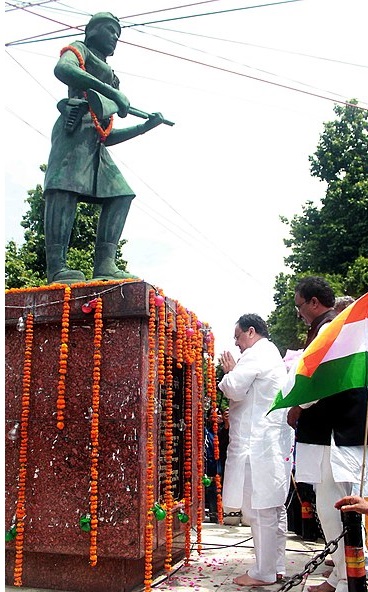
Statue of freedom fighter Uda Devi, at Sikandar Bagh, Lucknow
The UP government announced on 20 March 2021 the establishment of the Provincial Armed Constabulary (PAC) women's battalion named after Uda Devi, a female Dait freedom fighter.
Forbess-Mitchell, in Reminiscences of the Great Mutiny, writes of Uda Devi: “She was armed with a pair of heavy old-pattern cavalry pistols, one of which was in her belt still loaded, and her pouch was still about half full of ammunition, while from her perch in the tree, which had been carefully prepared before the attack, she had killed more than half-a-dozen men.
Lady sniper Uda Devi, a heroine of the Mutiny of 1857, earned the sobriquet “Dalit Veerangana”. She participated in the revolt against the British East India Company and led one of the fiercest battles in Lucknow, which was termed the Battle of Sikandar Bagh. She single-handedly killed as many as 32 British soldiers before succumbing on the battlefield on 16 November 1857.
She was born in a Dalit family in a village in the Oudh region and was married to Makka Pasi, a soldier in the Oudh army. She became an associate of Begum Hazrat Mahal and formed a women’s battalion under her command with help of the Begum of Oudh. Her husband was a martyr in the Battle at Chinhat which enraged Uda Devi and she vowed to avenge his death.
In the fall of 1857, a general revolt erupted in the cities of Delhi, Jhansi, and Kanpur against the growing hegemony of the British East India Company. In Lucknow, a small British garrison of 2200 clung to life on the banks of the Gomti River surrounded by rebels and lacking adequate supplies. A relief column of British soldiers broke through in September but lacked the firepower to leave again.
General Colin Campbell broke through the rebel lines and eventually saved the entrapped garrison. During this ‘Second relief of Lucknow,’ Campbell’s 93rd Highland, a large regiment of British troops under Colin Campbell attacked Sikander Bagh. The British forces met desperate resistance from rebels who had fortified the position. In the battle that followed, over 2000 rebels and many soldiers lost their lives in hand-to-hand combat. The British forces had to face a wall of thousands of Dalit women.
On 16 November 1857, Uda Devi climbed a banyan tree disguised as a man and killed 32 soldiers of the British army. After the British overran Sikandar Bagh, an officer noted that many of the British casualties had bullet wounds indicating a steep, downward trajectory. Suspecting that a sniper remained hidden in a nearby pipal tree, British officers fired at the tree and shot her dead. Further investigation revealed that the rebel was in fact Uda Devi Pasi, who had donned men’s clothing to participate in the uprising.
Living Tradition
On November 16 every year, the Pasis of Pilibhit, in particular, come together to commemorate the anniversary of Uda Devi’s martyrdom, who defied convention and struck a blow for the embryonic cause of Indian Independence. They come from all over West Bengal, Madhya Pradesh and Bihar to offer homage to the image of Uda Devi. In 1990, a statue of Devi was established. The construction of a 100 feet tall statue of Uda Devi was announced, in Lucknow, Uttar Pradesh. A park and a memorial dedicated to the Pasi icon are also being planned.
Source: Research paper on Unsung Heroes of Indian Freedom Struggle, IGNCA, New Delhi.